Mastering Charcoal Grilling: Techniques & Tips

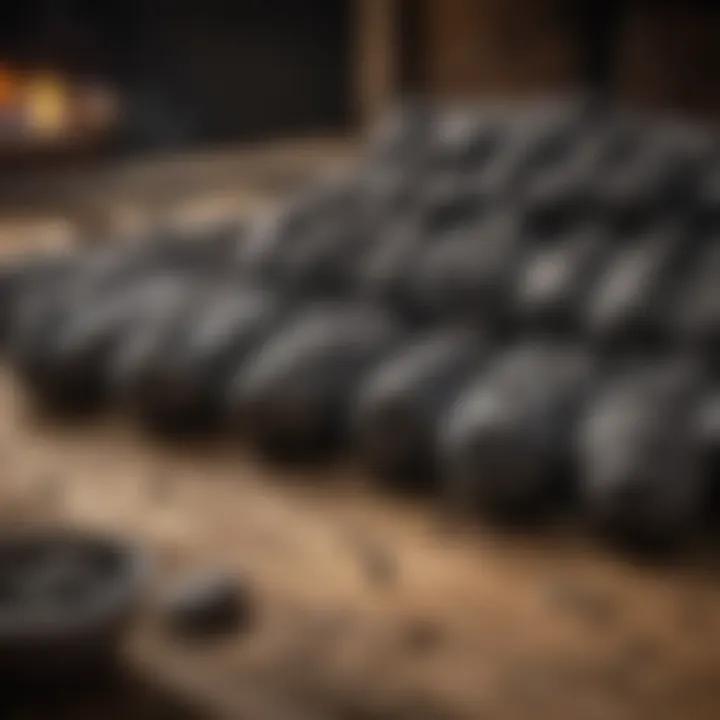
Intro
Grilling over charcoal is an art form cherished by many. The distinct flavor achieved through this method can elevate any dish from ordinary to extraordinary. Understanding the nuances of charcoal grilling is essential. Mastering various techniques and best practices leads to more than just a meal; it creates a memorable culinary experience.
This guide will delve into the different types of charcoal available, their preparation, grilling methods, and how to troubleshoot common issues that may arise while grilling. Both beginners and seasoned chefs will find value in these insights. The goal is to demystify the process and equip cooks with the knowledge needed to excel.
By the end of this article, you should feel confident in your ability to grill with charcoal. You will discover not just recipes but also methods that enhance flavor and ensure success on the grill.
Understanding Charcoal
Charcoal serves as a fundamental element in the art of grilling. Its type and quality can directly influence the flavor and cooking efficiency of grilled foods. Grasping the different aspects of charcoal can help both novice and experienced grillers make informed choices that enhance their grilling experience. Understanding charcoal involves exploring its composition, how it burns, and the various types available on the market. This knowledge is critical for achieving optimal grilling results.
The Science of Charcoal
Charcoal is produced through pyrolysis, a process that involves heating organic material in the absence of oxygen. This method removes moisture and volatile compounds, leaving behind a carbon-rich fuel. The chemical structure of charcoal allows it to burn steadily, providing a consistent heat source effective for grilling. The heat produced by charcoal can reach high temperatures, essential for searing meats and achieving the desired flavor profile, while also allowing for low-and-slow cooking sessions.
Types of Charcoal
Understanding the different types of charcoal is crucial for any grilling enthusiast. Each type has its own distinct characteristics, affecting flavor, heat production, and ease of use. Here's a deeper look into some common types:
Lump Charcoal
Lump charcoal is made from natural hardwood. Its key characteristic is that it burns hotter than other types of charcoal, making it ideal for grilling at high temperatures. Many grillers favor lump charcoal for its minimal additives and natural flavor production.
- Advantages: It lights quickly and provides a clean burn, yielding a delicious smoky flavor.
- Disadvantages: It can be inconsistent in size, leading to varied burn times.
Choosing lump charcoal can elevate the grilling process for those seeking authentic flavors.
Briquettes
Briquettes are a more standardized form of charcoal, often made from compressed sawdust and other additives. The defining feature of briquettes is their uniform shape and size, leading to more consistent burning. They are often favored for long cooking sessions due to their extended burn time.
- Advantages: They are widely available, easy to use, and create stable heat.
- Disadvantages: Additives can impart unwanted flavors to food, and they generally burn at lower temperatures compared to lump charcoal.
Briquettes can be an excellent choice for those looking for convenience and stability in their grilling.
Compressed Charcoal
Compressed charcoal, often found in tablets or discs, is a compact form of charcoal that ignites quickly. It is primarily used for portable grills. The main feature of compressed charcoal is its high energy density, which allows it to provide a steady burn in smaller quantities.
- Advantages: Convenient for travel and easy to ignite.
- Disadvantages: Limited flavor profile due to additives and potential for unhealthy smoke.
This type of charcoal can be useful for quick grilling experiences.
Flavored Charcoal
Flavored charcoal is infused with various natural materials such as fruit wood or herbs, targeting flavor enhancement during grilling. Its distinct sold characteristic is its ability to impart additional flavor without the need for wood chips.
- Advantages: It offers unique flavor opportunities for grilling without extensive preparation.
- Disadvantages: These charcoals may also contain additives, modifying taste undesirably.
For grillers looking to experiment with flavors, flavored charcoal can be an interesting option.
Through understanding the different types of charcoal, grillers can select the most suitable option for their cooking style, ensuring a flavorful and satisfying grilling experience.
Choosing the Right Charcoal
Choosing the right charcoal is fundamental for successful grilling outcomes. The type of charcoal can significantly affect the flavor, burn time, and ease of use. Therefore, making an informed choice is essential. Understanding the different properties and characteristics enables cooks to select a suitable charcoal for specific grilling tasks.
Factors to Consider
When choosing charcoal, certain factors should influence the decision-making process.
Flavor Profile
The flavor profile of the charcoal plays a vital role in achieving the desired taste in grilled foods. Different charcoals impart unique flavors. For instance, lump charcoal is known for its natural, smoky flavors, which enhance the taste of the meat. This makes it popular among grilling enthusiasts. In contrast, briquettes often contain additives that can alter the flavor. While many may not notice this, purists often criticize them. The unique feature of using a natural lump charcoal is that it burns cleaner. This is an advantage for health-conscious griller. However, these charcoals can burn faster, requiring more frequent additions to maintain cooking temperature.
Heat Duration
Heat duration indicates how long the charcoal can maintain its heat. This characteristic is crucial for grilling different types of food. Charcoal briquettes generally have a longer burn time compared to lump charcoal, making them suitable for longer grilling sessions. Their consistency allows cooks to predict heat levels more easily. However, this predictable heat can come with a drawback; they may not reach as high temperatures as lump charcoal. For tasks requiring intense heat, lump might be more beneficial despite its shorter cooking time. The unique feature here is the predictability, crucial for novice grillers still mastering timing.
Ease of Use
The ease of use of charcoal impacts the grilling experience. Briquettes, for instance, are often easier to light and require less attention once burning. This can be appealing to those who are new to grilling or prefer a simpler process. Meanwhile, lump charcoal needs more skill in starting and maintaining heat. However, it offers faster ignition and a more robust flavor. This trade-off may entice the more experienced griller aiming for an authentic flavor profile. Therefore, it is clear that ease of use varies based on personal preferences and grilling goals.
Sourcing High-Quality Charcoal
Sourcing high-quality charcoal can seem challenging due to the variety available in the market. However, knowing where and how to buy the best products can elevate your grilling experience. Look for local suppliers who specialize in charcoal. Additionally, online platforms like Amazon offer numerous choices, often with reviews that inform quality. You should also consider the sustainability practices of charcoal brands. Choosing responsibly sourced products supports environmental efforts.
Each element discussed reflects the importance of selecting the right charcoal for an exceptional grilling experience. The choices not only affect flavor but also the overall ease and duration of cooking.
Preparation Techniques
Preparation techniques are vital for successful charcoal grilling. They significantly affect not only the efficiency of grilling but also the quality of the food. Proper preparation ensures the right temperature is reached, which is essential for achieving the desired texture and flavor. Understanding how to light and arrange charcoal appropriately provides a solid foundation for any grilling session.
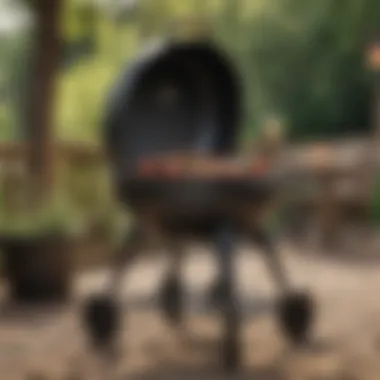
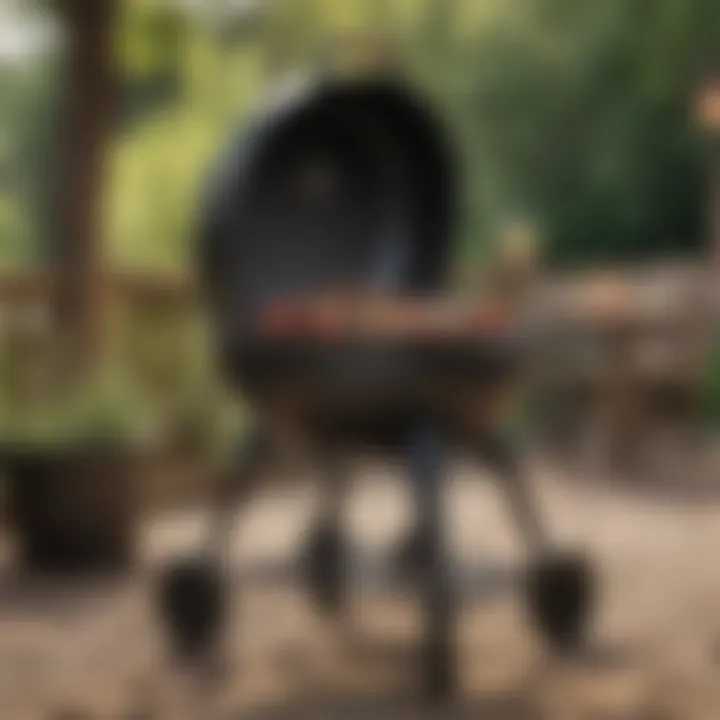
Lighting Charcoal
Lighting charcoal effectively is an initial step that can set the tone for the entire grilling experience. It requires knowledge of the tools available and the methods that yield quick, consistent ignition. Without proper lighting techniques, one may encounter uneven heating or inadequate burn times, negatively impacting the food being cooked.
Using a Chimney Starter
Using a chimney starter is a popular method among many grill enthusiasts. Its design allows for even airflow, which promotes more uniform heating. The key characteristic of a chimney starter is its ability to ignite charcoal without the need for chemical accelerants. This is beneficial for those who prefer a cleaner taste to their food.
A chimney starter usually consists of a metal container with a handle and a grilling grid at the bottom. Charcoal is packed at the top while crumpled newspaper or fire starters are placed underneath. When ignited, the flames rise through the charcoal, allowing for a fast and efficient burn. One advantage of this method is that it usually ensures that the charcoal reaches a consistent temperature before it is added to the grill.
Chemical Lighters vs. Natural Methods
The choice between chemical lighters and natural methods is another important aspect of lighting charcoal. Chemical lighters, like lighter fluid, are common for quick ignition. They are effective and available, providing convenience for many users. However, the key characteristic of these products is the potential for imparting undesired chemical flavors to food. This could compromise the pure, smoky taste that charcoal grilling is known for.
Conversely, natural methods might include using fire starters made from sawdust and wax or relying on newspaper and lighter cubes. These approaches generally do not alter the flavor of the food, aligning with a more traditional grilling philosophy. Still, they may take longer to ignite. Understanding the pros and cons of each method allows grillers to choose what aligns best with their cooking philosophy.
Arranging Charcoal for Grilling
Once the charcoal is lit and ready, arranging it correctly in the grill becomes critical. Each arrangement serves a unique purpose, enhancing the overall grilling process.
Direct Heat vs. Indirect Heat
Direct heat applies cooking directly over the flames. This technique is effective for quick-cooking food items such as burgers, steaks, and vegetables. The key characteristic of direct heat is the immediate exposure to high temperatures, achieving a nice sear or grill marks on the food.
However, this method can lead to uneven cooking if not monitored closely. Thicker cuts may require flipping to prevent burning. Thus, understanding how to use direct heat wisely is essential for successful grilling sessions.
On the other hand, indirect heat involves placing food away from the direct flames. This method is suitable for larger cuts of meat that need longer cooking times without burning. Its unique feature is that it allows for a slow, even cook, resulting in tender and juicy results. Understanding when to apply each method is critical for optimizing grilling results.
Two-Zone Fire
A two-zone fire is an advanced technique that utilizes both direct and indirect heat in the same grilling area. This arrangement is characterized by dividing the grill into a hot side and a cooler side. It is particularly beneficial for cooking a variety of foods at once, allowing for both searing and slow-cooking.
A two-zone fire allows the grill master to control the cooking temperatures intelligently. Items that require direct heat can be seared quickly and then moved to the cooler side to finish cooking without burning. This flexibility is advantageous for achieving ideal results across multiple items simultaneously, elevating the overall grilling experience.
Grilling Techniques with Charcoal
Grilling techniques with charcoal are foundational for capturing the essence of outdoor cooking. The method you choose greatly affects the flavor, texture, and overall success of the grilled food. Understanding both direct and indirect grilling techniques allows cooks to expand their culinary repertoire and refine their grilling skills. Each method offers unique benefits that cater to different types of foods and cooking styles.
Direct Grilling
Direct grilling involves cooking food directly over the heat source. This technique is efficient for quick-cooking items and creates desirable char marks and flavors.
Ideal Foods for Direct Grilling
When considering direct grilling, the ideal foods include thin cuts of meat, vegetables, and seafood. Fish fillets, chicken breasts, and steaks are excellent choices.
- Key Characteristics: Foods suited for direct grilling usually cook quickly and retain moisture. They are often marinated or seasoned before grilling to enhance their natural flavors.
- Benefits: This method results in a characteristic grill flavor and crisp texture. The higher heat helps seal in juices while creating an appealing crust.
- Unique Feature: Direct grilling is typically faster than other methods. However, it can lead to uneven cooking if not monitored closely.
Cooking Times
Understanding cooking times is vital for successful direct grilling. Thin cuts generally require less time, usually just a few minutes per side. For example, chicken breasts may take around 6 minutes, while fish cooks even quicker.
- Key Characteristic: Direct grilling demands precise timing based on the type and thickness of food.
- Benefit: Adequate knowledge of cooking times means the food can be grilled to the desired doneness, avoiding overcooking and drying out.
- Unique Feature: Shorter cooking times are suitable for smaller gatherings, making it enjoyable for casual cookouts. However, too much haste can lead to improperly cooked dishes if the chef is not careful.
Indirect Grilling
Indirect grilling uses a different approach, where food is placed away from the heat source. This method is optimal for larger cuts of meat and more complex dishes.
Smoked Dishes
Smoked dishes benefit from the indirect grilling technique that introduces wood smoke flavor, enhancing the overall dish. Ribs, briskets, and whole chickens are commonly smoked, yielding profound flavors.
- Key Characteristic: The low and slow cooking allows flavors from the smoke to permeate the meat.
- Benefit: Indirect grilling is favorable for tougher cuts, breaking down collagen and achieving tenderness.
- Unique Feature: While smoking requires more time and patience, it rewards chefs with exceptional flavor depth. However, it may not suit those seeking quick meal solutions.
Longer Cooking Times for Larger Cuts
Longer cooking times are necessary for larger cuts to ensure thorough cooking. Cuts such as roasts or whole turkeys can take several hours.
- Key Characteristic: Slow cooking in a controlled environment provides consistent heat, preventing the outer layer from burning while the inside remains undercooked.
- Benefit: This technique allows for versatility in flavoring, as marinades can be applied several hours beforehand.
- Unique Feature: While efficiency is less than that of direct grilling, the end result can be far superior in taste and texture, appealing to those who appreciate tender, flavorful meat.
Temperature Control
Temperature control is a critical element in grilling with charcoal. It determines how effectively food will cook, influencing both flavor and texture. Mastering temperature management allows cooks to achieve the desired doneness and avoid common issues such as flare-ups and uneven cooking. Knowing how to control heat can transform an ordinary grilling session into an exceptional culinary experience.
Assessing Heat Levels
Hand Test Method
The Hand Test Method is a time-tested approach for gauging grill heat. By holding your hand above the grill grate, you can categorize the heat level. Count the number of seconds you can comfortably keep your hand above the grill before pulling away. Here’s a simple breakdown:
- 2 seconds - Hot
- 4 seconds - Medium
- 6 seconds - Low
This method is beneficial as it requires no tools and can be done quickly. However, it also has drawbacks. It relies on the individual's sensitivity to heat, which can vary.
Using a Thermometer
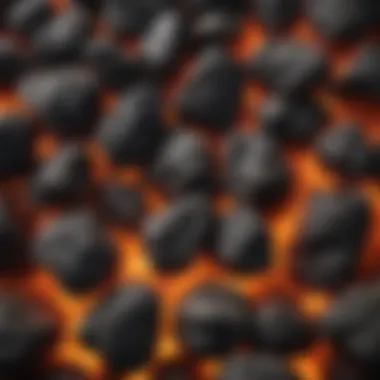
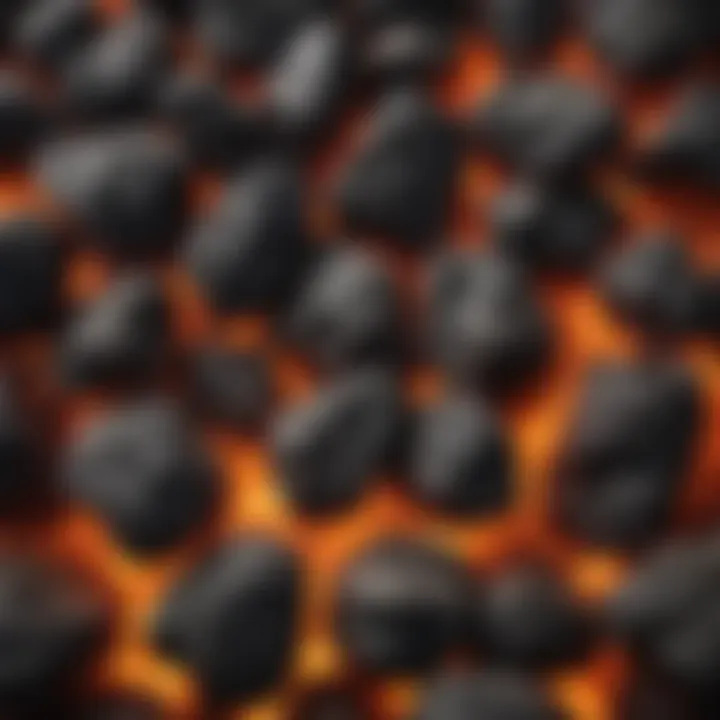
Using a thermometer offers a precise way to measure temperature. A probe thermometer can be inserted into the thickest part of the meat to ensure it reaches the correct internal temperature. This method is highly reliable and can be used for various foods. With a thermometer, you eliminate guesswork. However, it requires an initial investment in equipment, which may not be ideal for all grillers.
Maintaining Temperature
Adding Charcoal
Adding charcoal is an essential part of maintaining heat in the grill. When food is cooking for extended periods, the initial charcoal can burn out. Adding additional charcoal helps sustain cooking temperature. It is important to use the same type of charcoal to keep flavor profiles consistent. This method is favored for its simplicity. However, timing is critical; adding too late may reduce cooking efficiency.
Ventilation Adjustment
Ventilation plays a significant role in temperature control. By adjusting the air vents on the grill, you can increase or decrease the airflow, which in turn modifies the flame intensity. More airflow results in higher heat, while less airflow lowers the temperature. This method is advantageous because it is straightforward and requires no extra materials. Nonetheless, it demands constant attention to avoid temperature spikes or drops, which can be challenging for some cooks.
Flavor Enhancement Techniques
Flavor enhancement techniques are vital for anyone wishing to optimize their grilling experience. They offer ways to deepen the taste of food cooked on a charcoal grill. Charcoal itself imparts a unique smoky flavor, but additional methods can elevate this even further. These enhance both fragrance and taste, making the grilling experience more enjoyable.
Utilizing flavor enhancement techniques can transform a basic meal into a delectable culinary event. Techniques such as adding wood chips and marinating allow for customization according to one’s personal taste. Understanding these methods can lead to better grilling outcomes and a more rewarding experience at the grill.
Wood Chips and Their Uses
Types of Wood Chips
Wood chips play a significant role in adding complexity to the grilled food. Different types of wood chips, such as hickory, mesquite, and applewood, each bring their own unique profiles to the flavor. For example, hickory is known for its bold taste, while applewood offers a sweeter, milder flavor. Choosing the right type can enhance the overall taste experience.
The key characteristic of wood chips is their ability to smoke at lower temperatures. This contributes to a slow infusion of flavor. The unique feature of these chips is how they burn and smolder. Some varieties might produce more heat, which can be advantageous, but they can also lead to bitter tastes if overused. Thus, choosing the right type is crucial for desired flavors.
Soaking Wood Chips
Soaking wood chips in water before use is a common practice among grillers. This technique helps to slow down the burning process. As a result, it allows the chips to produce smoke for a longer duration. The key characteristic of soaking is that it prevents quick combustion. This means your food receives a gentler infusion of smoke flavor.
However, soaking wood chips can have its drawbacks. Too much water may diminish the intensity of the smoking effect. It is also important to dry them a bit before placing them on hot charcoal. The unique feature of this method is its ability to control smoke production and flavor delivery. Balancing soak time is essential for maximizing flavor benefits.
Marinating and Seasoning
Importance of Marinades
Marinades are an essential element in flavor enhancement. They not only improve taste but also tenderize the meat, further adding to the grilling experience. The importance of marinades lies in their ability to penetrate the meat, infusing it with flavor throughout. Ingredients in marinades such as herbs, spices, and acids can interact in ways that elevate the food’s natural profile.
The unique aspects of marinades can impact various proteins differently. For example, acidic components like vinegar may make chicken juicier. Yet, they may toughen red meats if left for too long. Understanding how to properly use marinades can be a game changer, enhancing the final dish with flavorful depth.
Timing of Application
The timing of when to apply marinades can considerably change outcomes. Applying a marinade too early can lead to an overpowering taste. Conversely, applying it too late might not yield sufficient flavor. A general guideline suggests marinating for at least 30 minutes to a few hours, depending on the protein.
The key characteristic of proper timing is ensuring the flavors have time to meld into the meat while avoiding excessively long marination, which could negatively affect texture. Thus, knowing how and when to use marinades is crucial for achieving the best flavors in grilled foods.
"Properly utilizing flavor enhancement techniques is essential for creating memorable grilled dishes."
In summary, flavor enhancement techniques bring depth to charcoal grilling. Understanding and applying methods like wood chips and marinades can substantially improve dishes and overall satisfaction. As you explore these techniques, keep in mind the delicate balance between flavors and cooking methods for the best results.
Safety Practices
Understanding safety practices is fundamental when it comes to grilling with charcoal. Grilling can be a delightful activity, but it also involves risks that require awareness and preparation. The main focus is to mitigate hazards and ensure a safe cooking environment. This section outlines essential safety measures that can drastically reduce the chances of accidents and injuries during the grilling process.
Fire Safety
Proper Ventilation
Proper ventilation ensures that there is a safe flow of air around the grill. This is critical for preventing carbon monoxide buildup, which can lead to serious health risks. Good ventilation can also improve burn efficiency, allowing charcoal to reach optimal temperature quickly.
Many new grillers may underestimate the value of sufficient airflow around the grill. Not only does it enhance combustion, it also aids in controlling flame intensity. The unique feature of proper ventilation is its ability to help manage smoke and heat dispersal. Poor ventilation may result in uncomfortably high smoke levels or inconsistent grill temperatures, making it less enjoyable for everyone involved.
Emergency Procedures
Having a set of emergency procedures ready is crucial. Grilling accidents can happen unexpectedly. Knowing what steps to take can help mitigate risks and handle emergencies efficiently. Key characteristics of effective emergency procedures include clarity and accessibility. Each person involved in the grilling process should be aware of the plan.
A notable feature is the inclusion of clear roles in an emergency. This may involve designating someone to call help, while another person focuses on controlling the situation. The advantage of being prepared is that it reduces panic in stressful situations. However, if these procedures are not communicated or rehearsed, they can fail when needed.
Handling Charcoal and Grilling Equipment
Protective Gear
Protective gear is another vital aspect of grilling safety. Items like fire-resistant gloves or heat-resistant aprons can help protect against burns and injuries while handling hot equipment or charcoal. The key feature of protective gear is its ability to offer a barrier between the individual and potential hazards. Wearing such gear is a proactive choice that provides peace of mind when grilling.
It’s essential to choose the right kind of protective gear for your specific grilling setup. The advantage here is that it allows for safer handling of tools and equipment that may be dangerously hot or sharp. Nevertheless, some may find wearing protective gear uncomfortable, especially in hot weather, which can affect your grilling comfort.
Cleaning Up After Grilling
Cleaning up after grilling is not just about aesthetics; it is essential for safety as well. Improperly disposed of charcoal can pose a fire risk, and unclean tools can lead to contamination of food during the next grilling session. Focused attention on cleaning minimizes these risks.
Key characteristics of an effective cleaning routine include systematic clearing and sanitizing of all surfaces and tools used. This habit ensures that your next grilling session is both safe and smooth. The unique aspect here is the prevention of cross-contamination, which is critical for food safety. On the downside, the cleaning process can sometimes be overlooked, leading to complications later.
"An ounce of prevention is worth a pound of cure."
This principle applies aptly to grilling safety, emphasizing the importance of preventive measures before and after the process.
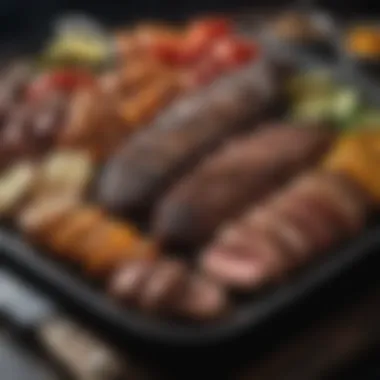
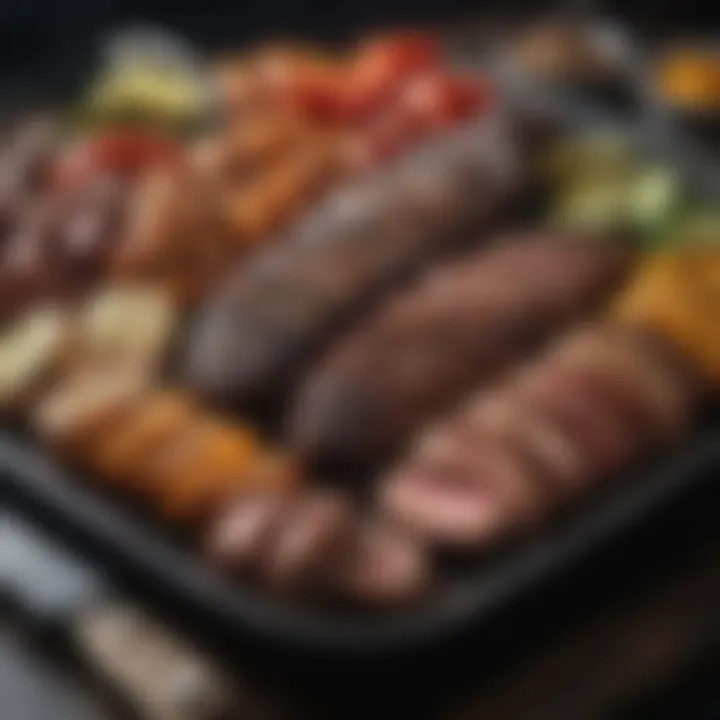
Grilling Equipment
The significance of grilling equipment cannot be overstated when it comes to maximizing the potential of charcoal grilling. It directly influences the cooking efficiency, flavor development, and overall grilling experience. Having the right equipment not only makes the grilling process more efficient but also elevates the quality of the food being prepared. Understanding the distinctions between various equipment types and their unique functionalities can lead to improved culinary outcomes.
Charcoal Grills vs. Gas Grills
Charcoal grills remain a preferred choice for many grilling enthusiasts who value the authentic smoky flavor that charcoal imparts to food. Unlike gas grills, which utilize propane or natural gas, charcoal grills rely on natural wood-based products that ignite to provide heat. This setup allows for temperature variability and gives users the ability to employ smoking techniques that enhance the taste of grilled items.
Gas grills, while convenient and often easier to control in terms of temperature, can lack the depth of flavor that comes from charcoal grilling. A critical aspect to consider is how each grill type fits individual grilling styles and preferences. Charcoal grills may require more time to heat and meticulous monitoring, whereas gas grills provide instant heat at the push of a button. Novice grillers might gravitate towards gas grills for their user-friendly nature, while more experienced cooks might opt for charcoal to master the art of flavor manipulation.
Essential Accessories
Grill Tools
Grill tools are indispensable for achieving successful grilling results. They include items such as tongs, spatulas, grill brushes, and skewers. The ergonomic design of these tools ensures safe handling of hot food items, minimizing the risk of burns or accidents when working with high heat. For example, long-handled tongs are particularly favored because they allow for a safe distance from the heat source while effectively flipping or moving food.
These tools enhance functionality, making food handling easier and more efficient during the cooking process. It's crucial to select tools made from stainless steel or heat-resistant materials to ensure durability. Choosing tools based on their specific design and intended use can simplify the grilling experience.
Thermometers
Thermometers play a vital role in achieving precise cooking results when grilling with charcoal. They enable cooks to monitor the internal temperature of meats, ensuring that food is safely cooked while retaining optimal juiciness. Instant-read thermometers and probe thermometers are common options available to users. The ability to avoid overcooking or undercooking enhances the overall culinary result and improves meal satisfaction.
Using thermometers adds a layer of sophistication to grilling, as it turns a subjective process into an objective one. Many grillers find this tool beneficial because it minimizes guesswork and allows for repeatable successes in cooking.
Chimney Starters
Chimney starters are essential for those who wish to light charcoal efficiently and safely. They function by allowing charcoal to ignite rapidly through direct airflow without the need for chemical accelerants. This method is not only safer but also yields a cleaner taste in food by avoiding the residual flavors that lighter fluids can impart.
The design of chimney starters facilitates quick lighting, meaning grillers can start cooking sooner and with less hassle. This equipment becomes particularly advantageous during busy cooking periods or when time is of the essence, helping to streamline the entire grilling process.
In summary, investing in quality grilling equipment like charcoal grills, grill tools, thermometers, and chimney starters significantly impacts the grilling experience, making it safer and more effective. Local resources such as Wikipedia and Britannica can provide additional insights into proper usage and maintenance of grilling equipment, contributing further to a well-rounded grilling practice.
Troubleshooting Common Issues
Troubleshooting common issues is a crucial aspect of charcoal grilling. Understanding how to recognize and address problems ensures a smoother grilling experience. Often, difficulties arise from insufficient knowledge of equipment, ingredients, or techniques. By mastering this section, cooks can maintain control over the grilling process and achieve optimal results.
Flare-Ups
Flare-ups are sudden bursts of flames that can occur when fat drips onto hot charcoal. While they might seem exciting, they can lead to uneven cooking or burnt food. To mitigate flare-ups, it is essential to manage the fat content of the food. Here are some strategies:
- Trim excess fat from meats, which reduces drippings.
- Use a two-zone fire method. This involves creating a hot side and a cooler side in the grill. When flare-ups occur, move the food to the cooler side until the flames subside.
- Monitor closely. Stay attentive during cooking, so you can respond swiftly by adjusting the food's position.
Proper management of flare-ups can enhance your grilling experience and ensure flavorful results.
Uneven Cooking
Uneven cooking often results from inconsistent heat distribution in the grill. This can lead to some parts of the food cooking faster than others. Several factors contribute to this issue:
- Coal arrangement: Ensure that charcoal is spread evenly across the bottom of the grill. Uneven charcoal placement can create hot and cold spots.
- Food placement: Place smaller or thinner items where the heat is strongest. Larger cuts benefit from the cooler side.
- Cooking technique: Use lids to trap heat, promoting even cooking throughout the food. Check for doneness at various points to ensure thorough cooking.
Insufficient Heat
Insufficient heat can significantly hinder cooking, leading to undercooked meats and disappointment at the table. Several causes can lead to this problem:
- Low charcoal quantity: Ensure enough charcoal is used for the cooking method chosen. It is vital to preheat the grill before placing food on it.
- Damp charcoal or wood: If charcoal or wood is wet, it won’t burn efficiently. Store charcoal in a dry place and check for moisture before use.
- Ventilation issues: Proper airflow is essential for a hot fire. Adjust the vents on the grill to improve airflow and fuel combustion. Tight draws can extinguish flames.
By recognizing and addressing these issues, you can greatly enhance your grilling skills, leading to delicious and perfectly cooked meals.
Culinary Trends in Charcoal Grilling
Culinary trends in charcoal grilling are shaping how food enthusiasts approach their outdoor cooking experiences. These trends reflect a growing desire for unique flavors, innovative techniques, and an appreciation for regional traditions. Embracing these aspects not only enhances the grilling experience but also encourages chefs and home cooks alike to experiment.
Regional Variations in Grilling Techniques
Regional variations in grilling techniques offer insight into local ingredients and cultural influences. In the southern United States, for instance, low-and-slow grilling methods prevail, often incorporating wood smoke for flavor. This technique is well-suited for pork shoulder or ribs, allowing for a tender, smoky finish. In contrast, Korean barbecue emphasizes quick, high-heat grilling, often with marinated meats like bulgogi or galbi. The quick cooking time preserves the meats' natural juices and flavors, resulting in a completely different culinary experience. Understand the distinctions between these approaches can elevate a cook's overall skillset. Familiarity with local traditions and preferences may encourage diners around the world to choose charcoal grilling for both its flavor depth and its social experience.
Innovative Charcoal Grilling Recipes
Innovative charcoal grilling recipes are at the forefront of modern cooking. Chefs and home grillers continually seek to push boundaries, leading to unique dishes that showcase the versatility of charcoal. Recipes that incorporate unconventional ingredients are gaining popularity as well. For example, grilled pizza topped with fresh vegetables and artisan cheeses is becoming a favored choice among food lovers.
Other noteworthy trends include grilled fruits and desserts, which utilize the natural sweetness intensifying through the grilling process. Peaches and pineapples are particularly popular when caramelized on the grill and served as a side dish or dessert.
Today’s grilling scene encourages creativity. By experimenting with various techniques and flavor combinations, one can create dishes that impress and excite guests.
Epilogue
End
The conclusion of this article serves as a pivotal moment to reflect on the intricate relationship one develops with charcoal grilling over time. Each section previously discussed highlights not just technical knowledge, but also the overall experience that charcoal grilling can offer.
Grilling with charcoal involves both science and art. From understanding the types of charcoal available for purchase to mastering temperature control, every aspect enhances the grilling process. Recognizing which techniques suit specific foods can significantly elevate the flavor and texture of grilled meals. Moreover, the emphasis on safety practices ensures that this culinary passion can be enjoyed responsibly.
In summary, the key points discussed include:
- Types of Charcoal - Understanding the differences aids in selecting the best one for specific grilling needs.
- Preparation Techniques - Lighting and arranging charcoal effectively sets the foundation for successful grilling.
- Grilling Methods - Knowledge of direct vs. indirect grilling allows for better cooking results.
- Temperature Control - Mastery over heat enhances the cooking process.
- Flavor Enhancement - Various techniques add depth to dishes.
- Safety Practices - Safe grilling ensures an enjoyable experience.
Summarizing Key Points
Overall, this overview encourages readers to integrate learned techniques and best practices into their charcoal grilling endeavors. The details covered provide both novices and experienced grillers knowledge necessary to achieve superior results. Grilling is not merely about enjoying food; it’s about the experience of grilling itself. Thus, understanding each dimension of charcoal grilling not only elevates food quality but also enriches the grilling experience.
Encouragement for Exploration
As you continue your journey in the world of charcoal grilling, do not hesitate to explore new methods and recipes. Charcoal grilling can be an experimental playground, with each grilling session an opportunity to refine skills and try innovative techniques. Consider joining community forums on platforms like Reddit or engaging with local grilling clubs to share experiences and gain insights.
Enrich your grilling repertoire by trying out various wood chips, marinades, and seasoning methods. Each attempt will foster greater understanding and mastery. As you develop confidence in your grilling skills, you’ll discover that the possibilities are only limited by your imagination. Happy grilling!







